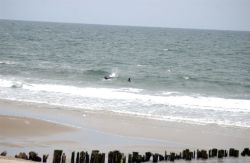Jamaica Bay and the Rockaways
Leif Ericson Drive
Leif Ericson (c.960-c.1020), for whom this stretch of the Belt Parkway (from Fort Hamilton Parkway to Knapp Street) is named, was probably the first European to set foot on the American continent, nearly 500 years before Christopher Columbus’s voyages.
Ericson was born in Iceland around 960, the son of Eric the Red, an Icelandic king who discovered and colonized Greenland. The Icelandic Sagas offer two explanations of Ericson’s famous voyage. One suggests that Ericson, en route to Greenland, was blown off course and arrived on the northeastern coast of America. In the other, he organized an expedition to confirm a previous report of hilly, heavily forested land west of Greenland.
The Sagas record that Ericson – afterwards known as “Leif the Lucky” - made three significant land discoveries in the year 1000. He named the first Helluland (Flat-Stone Land), now thought to be Labrador. He called the second Markland (Wood Land), possibly Newfoundland. The site of the third landfall, named Vinland (Vine Land) for the wild grapes found there, may have been as far north as Newfoundland or as far south as Cape Cod. The crew wintered in Vinland and returned to Greenland in 1001, drawing “behind them a boat filled with grapes.” Within the next 20 years, Leif’s brother Thorvald returned to Vinland, and encountered Native Americans there, who they called skraelings. According to the Sagas, the Vikings attacked the “skraelings,” killing eight of the nine they found. In response, the Native Americans killed Thorvald.
In 1964 President Lyndon B. Johnson, supported by a unanimous Congress, proclaimed October 9 as “Leif Ericson Day.” Ericson has long been a hero to the Norwegian people, and eight centuries after his Atlantic voyage, Norwegians began to migrate to American shores. A large number arrived in New York after 1825, and many made their homes in Brooklyn. By the turn of the century, the neighborhood of Bay Ridge supported a variety of Norwegian cultural, charitable, and business institutions.
The Belt Parkway was one of many parkways in the New York metropolitan area built by Robert Moses (1888–1981). Inspired by city planner Frederick Law Olmsted (1822–1903), Moses, as the chairman of the Long Island State Parks Commission, lobbied for the construction of the Laurelton Parkway, which began in February 1930. A component of Moses’s “great parkway plan” developed in 1924, the thoroughfare was part of the future Parks Commissioner’s vision to increase automobile access to the five boroughs, as well as Westchester County and Long Island. This in turn allowed for a closer integration of outlying city areas and unrivaled access to recreation areas.
In December 1937, Moses wrote to Mayor Fiorello H. LaGuardia (1882–1947) to request that he and the Board of Estimate approve the selection of rights of way for arterial parkways in Brooklyn, The Bronx, and Queens. “Landscaped parkways . . . have been proven not only to be the most efficient way of providing for a smooth flow of traffic, but also to be great neighborhood assets from the point of view of desirable residential growth,” he wrote, “especially if provision is made for neighborhood playgrounds and for walks along these parkways so that they can be enjoyed by local residents and pedestrians as well as motorists.”
Moses considered Shore Parkway, and the rest of the Belt Parkway, to be a “continuous park system, not merely an automobile artery, a system of shoestring parks and recreational facilities encircling the entire metropolis….” Examples of such parks along Leif Ericson Drive include Dyker Beach Park, Bensonhurst Park and Dreier-Offerman Park.
The Belt Parkway System opened in 1940 to great fanfare. The dedication ceremonies were broadcast on five radio stations and a motorcade carrying dignitaries christened the entire length of the parkway, from Dyker Beach in Brooklyn to the intersection with the Whitestone Parkway. The $28 million project was funded by the federal Public Works Association and the City.
Shore Parkway was renamed “Leif Ericson Drive” in 1969 by the City Council to acknowledge the large Scandinavian population in Bay Ridge. Two other Parks properties in Brooklyn bear Ericson’s name -- Leif Ericson Park and Square lie on five blocks between 66th and 67th Streets stretching from Fourth Avenue to Fort Hamilton Parkway, and a playground named for the explorer opened in 1936 on an adjacent parcel of land.
Check out your park's Vital Signs
Clean & Safe
Green & Resilient
Empowered & Engaged Users
Share your feedback or learn more about how this park is part of a
Vital Park System

Know Before You Go
Ecology Park is only open at certain times of year when Parks staff are present in order to protect this unique landscape. Want to visit? Check out our Stewardship Projects page for restoration, planting, and educational events.



